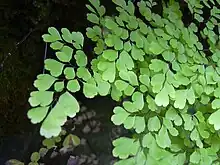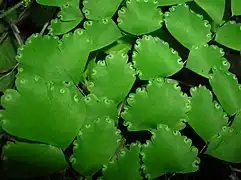Adiantum raddianum
Adiantum raddianum, the Delta maidenhair fern, is one of the most popular ferns to grow indoors.[3] It is native to South America and its common name comes from its shiny, dark leafstalks that resemble human hair.[4] It typically grows about 17–19 in (43–48 cm) tall and up to 22 in (56 cm) wide.[5] In the wild, it is found on forest floors, rock crevices, river banks, coastal cliffs, and basalt banks along trails and streams.[6] The triangular fronds are semi-erect in the beginning then droop gracefully as they age and can be up to 12 inches (30 cm)[7] long by 6 inches (15 cm) wide. The genus name Adiantum comes from the Greek word "adiantos", meaning "unwetted" (in reference to the leaves).[5]
| Adiantum raddianum | |
|---|---|
 | |
| Scientific classification | |
| Kingdom: | Plantae |
| Clade: | Tracheophytes |
| Division: | Polypodiophyta |
| Class: | Polypodiopsida |
| Order: | Polypodiales |
| Family: | Pteridaceae |
| Genus: | Adiantum |
| Species: | A. raddianum |
| Binomial name | |
| Adiantum raddianum | |
| Synonyms[2] | |
|
List
| |
This plant is hardy down to 5 °C (41 °F), so must be grown indoors in temperate regions. However it may be placed outside in a sheltered spot during the summer months.[8] It requires high humidity, well-drained soil, bright indirect light, and a fairly constant temperature.[3] It prefers neutral or slightly alkaline soil and is suitable for USDA hardiness zones 10 and 11.[9] It can be susceptible to scale and mealybug.[4] The cultivars ‘Brilliantelse’ and ‘Kensington Gem’ have won the Royal Horticultural Society's Award of Garden Merit.[8][10]
A. raddianum is sometimes considered invasive in Hawaii and French Polynesia.[6]
Gallery
References
- "NatureServe Explorer". Retrieved 2021-03-31.
- "Adiantum raddianum C.Presl". Plants of the World Online. Board of Trustees of the Royal Botanic Gardens, Kew. 2017. Retrieved 21 December 2020.
- Adiantum raddianum, Missouri Botanical Garden.
- "Delta Maidenhair Fern - Adiantum Raddianum - Indoor Care And Description". www.houseplantsexpert.com. Retrieved 2021-03-31.
- "Maidenhair Fern: How To Grow and Care For Adiantum Raddianum". Plant Care Today. 2020-05-17. Retrieved 2021-03-31.
- "Adiantum raddianum (delta maidenhair fern)". CABI Invasive Species Compendium. November 20, 2019. Archived from the original on 2015-03-02. Retrieved March 31, 2021.
- Adiantum raddianum, NC Cooperative Extension.
- "Adiantum raddianum". Royal Horticultural Society. Retrieved 3 January 2018.
- "Adiantum raddianum (Delta Maidenhair)". Gardenia.net. Retrieved 2021-03-31.
- "AGM Plants - Ornamental" (PDF). RHS. 2017. Retrieved 3 January 2018.
External links
 Media related to Adiantum raddianum at Wikimedia Commons
Media related to Adiantum raddianum at Wikimedia Commons

.jpg.webp)

